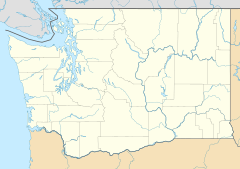Cumberland, Washington facts for kids
Quick facts for kids
Cumberland, Washington
|
|
|---|---|
| Country | United States |
| State | Washington |
| County | King |
| Elevation | 850 ft (260 m) |
| Time zone | UTC-8 (Pacific (PST)) |
| • Summer (DST) | UTC-7 (PDT) |
| ZIP codes |
98022
|
| Area code(s) | 360 |
| GNIS feature ID | 1518407 |
Cumberland is a small community in King County, Washington. It's called an "unincorporated community" because it doesn't have its own local government like a city does. It's part of the larger county.
Cumberland started as a mining camp. It was named in 1893 by F.X. Schriner. He named it after the Cumberland coal area in the Appalachian Mountains. A post office opened here on October 13, 1894. Today, the Enumclaw post office handles mail for this area.
Many other mining camps in the region have disappeared. But Cumberland can still be found in the Cascade foothills. It's located between Nolte State Park and Kanaskat-Palmer State Park. You can reach it by using the backroads in Southeast King County. Several smaller mines were once in the area. These included the "Navy" mine and the Hyde mine, located just outside of town.
Cumberland is served by the KCFD #28 Fire Department. This department is also known as the Enumclaw Fire Department. It is also a registered voting area within King County.
Contents
Protecting Cumberland's Environment
In 1989, a group called "Metro" (Metropolitan King County) had a plan. Metro was in charge of transit and sewage waste for the county. They planned to spray sewage sludge waste on 400 acres (1.6 km2) of woods. These woods were northwest of Cumberland. The plan was set to last for 25 years.
Community Stands Up
The community of Cumberland did not like this plan. They started a protest, led by Valerie Cunningham. The Muckleshoot Native American tribe also objected. Their tribal lands are downriver on the nearby Green River. Other environmental groups joined in the protests too.
Because of these objections, Metro agreed to study the plan. They created an Environmental impact statement (EIS). This report looks at how a project might affect the environment. The EIS showed that the sewage sludge contained harmful substances. These included toxins and heavy metals. Due to these findings, Metropolitan King County officially canceled the project in 1992.
Valerie Cunningham and Fair Representation
After the sewage sludge fight, Valerie Cunningham and her group realized something important. They felt that the Metro Council did not fairly represent rural communities. Some Metro districts had two representatives. Others had four. This meant that the districts did not have "one person, one vote" representation. This idea means that everyone's vote should count equally.
A Lawsuit for Equal Votes
The American Civil Liberties Union (ACLU) helped Ms. Cunningham. They represented her in a group lawsuit. She won the case. As a result, the voters of King County made a big decision. They voted to combine the Metropolitan Municipality of Seattle council with the King County council. This change helped make sure that all communities had fair representation.
See also
 In Spanish: Cumberland (Washington) para niños
In Spanish: Cumberland (Washington) para niños



